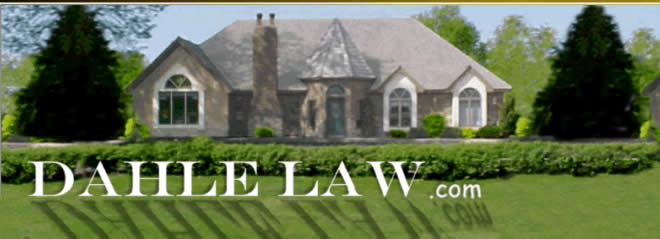Brightwood Hills Golf Course – 50 Years
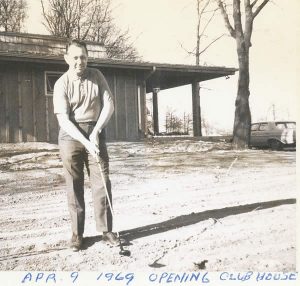 Brightwood Hills Golf Course – 50 Years
Brightwood Hills Golf Course – 50 Years
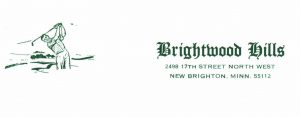 Vincent Dahle’s Vision
Vincent Dahle’s Vision
In 1963, Vincent Dahle moved his family from Minneapolis to New Brighton, then a relatively unknown Minnesota community midway between St. Paul and Anoka.
The Dahle family occupied a former hobby horse farm located on the western side of Silver Lake Road – then a two lane, low traffic avenue having a northern terminus at Rice Creek Road.
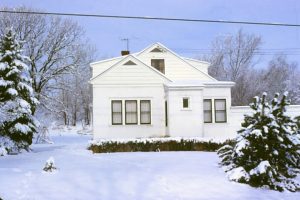
Gazing eastward across Silver Lake Road to a vacant 40 acre parcel of land, Vince Dahle declared to himself that it would make a good golf course – and Brightwood Hills would be its name.
Brightwood Hills – Origin
After acquiring the 40 acre mixture of prairie, oak forest, and wetlands, Dahle sought and eventually received approval for a subdivision plat known as Wedgewood Addition – which included the future Brightwood Hills golf course.
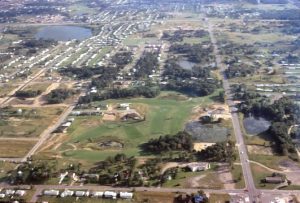
Dahle then brought in the excavators to shape the contours of the nine hole golf course, planted hundreds of pine seedlings on the edges of the future fairways, connected the wetlands into an integrated water system, and designed the layout of each hole with the assistance of the former greenskeeper at the Columbia Golf Course in Minneapolis.
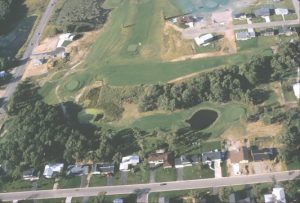
While all of the oak trees existing on the golf course were native to the region, the beautiful pine trees which are currently located on the course were planted by Dahle.
Brightwood Hills – Homesites
Surrounding the newly designed golf course were various home sites which were soon purchased by would-be homeowners desiring to have park-like open spaces adjacent to their backyards, in the Wedgewood Addition and Brightwood Hills Addition subdivisions.
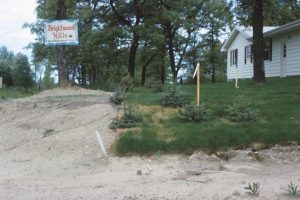
 Early homeowners and longtime residents on the golf course included the Moore family – which built a large home adjacent to the seventh tee, the Conroy family – which built a large home high on a hill above the second green, the Harty family – overlooking the 3rd and 4th holes, the Haugo family – located behind the original 7th green, and the Dahle family – which built the first home on Brightwood Hills behind the fifth green.
Early homeowners and longtime residents on the golf course included the Moore family – which built a large home adjacent to the seventh tee, the Conroy family – which built a large home high on a hill above the second green, the Harty family – overlooking the 3rd and 4th holes, the Haugo family – located behind the original 7th green, and the Dahle family – which built the first home on Brightwood Hills behind the fifth green.
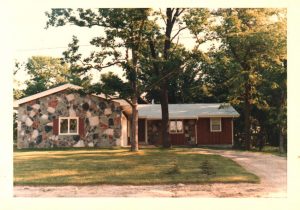
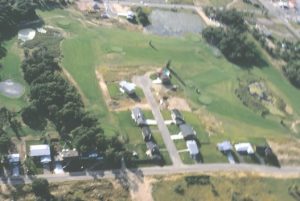
Brightwood Hills – Grand Opening
In April of 1969, Brightwood Hills welcomed its first golfers to the par-30 golf course.
Charter Memberships were $50.00 for an individual, and $75.00 for a married couple.
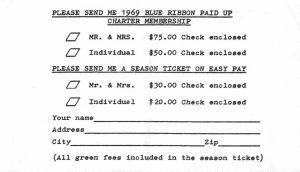
The original clubhouse was a small but comfortable building with a covered porch having views of the first tee, and the ninth green. Brightwood Hills was notable for its robust flowerbeds.
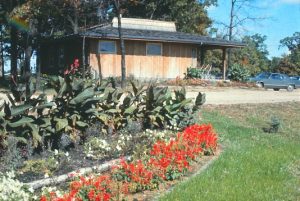
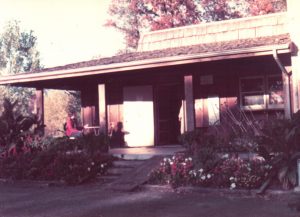
Brightwood Hills – Clubhouse Attendants
During its early years, Brightwood Hills was able to employ outstanding clubhouse attendants – including Lyle Hanson, Greg Adams, Jerry Bennek, Byron Walker, Art Hovland, Jay Moore, Bob Conroy, and Tom Conroy.
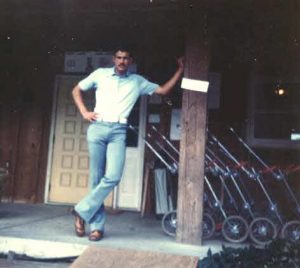
Brightwood Hills – Driving Range
One unique feature at the facility initially was a short-distance driving range where golfers could hit floating golf balls into the pond adjacent to Silver Lake Road. The golf balls were subsequently retrieved manually with the assistance of a floating raft, and reused by the next round of golfers.
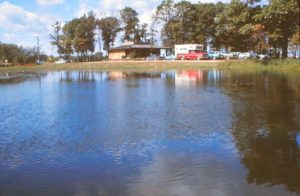
Brightwood Hills – Local Suppliers
During its early years, Brightwood Hills obtained various supplies and materials for its operation from Beisswenger’s New Brighton Hardware, and various items of golf course maintenance equipment from New Brighton’s Paron Motors.
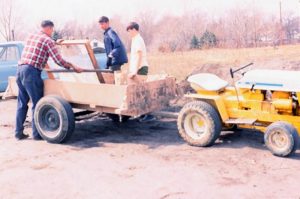 Darrell Kitner – a mechanical genius – was essential in keeping the equipment at the course operating. The yellow tractor was from New Brighton’s Paron Motors.
Darrell Kitner – a mechanical genius – was essential in keeping the equipment at the course operating. The yellow tractor was from New Brighton’s Paron Motors.

Brightwood Hills – Local Employer
Brightwood Hills employed many neighborhood residents during its early years, including several members of the Conroy and Moore families, long time greenskeeper Michael Gaffron, and numerous other part-time employees necessary to cut the grass, water the greens, operate the clubhouse, and otherwise keep the course in tip-top shape for the golfing public.
Brightwood Hills – Junior Tournament
One of the highlights of every summer was the Brightwood Hills Junior golf tournament – offering two flights of competition – the higher flight suitable to the most skilled junior golfers, and the lower flight to those just learning to love the game.
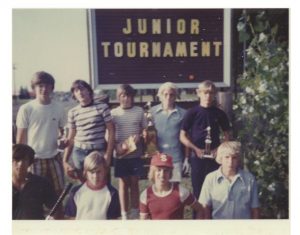
Brightwood Hills – Leagues
In its early years, Brightwood Hills had an active Women’s League which was administered for many years by Bunny Hastay, and a number of active Men’s Leagues – including a Monday night league in which many of New Brighton’s leading citizens participated.
Brightwood Hills – Cross-country Skiing
Beginning in the winter of 1970, Brightwood Hills began offering cross-country skiing during the winter months, providing groomed trails and equipment rentals. One especially popular feature in the winter was its lighted trails – which allowed for nighttime skiing.
Brightwood Hills – Indoor Golf
During the summer of 1972, a major expansion was made to the clubhouse, which included four separate stalls designed especially for indoor computerized golf – complete with regulation size putting cups which allowed for all golfing activities from tee to green.
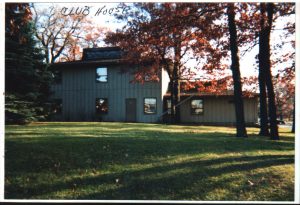
A computerized golf system was obtained from an Iowa indoor golf operation which had failed the previous year, and beginning in the winter of 1972, Brightwood Hills began offering computerized golf – with on-screen images from Doral Country Club in Florida, Congressional Country Club in Washington DC, and Pebble Beach Golf Course in California.
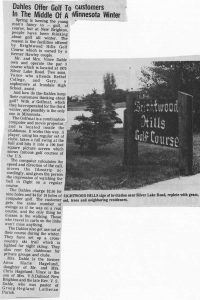
The indoor computerized golf at Brightwood Hills was in high demand from December through March, and many regulars came every week in order to keep their game at a high level.
The computerized golf technology from the early 1970s consisted of filmstrips and a sound activation system which calculated the number of frames the filmstrip was to advance, based upon the amount of time between the click of the golf ball upon impact, and the breaking of a light barrier behind the screen at which the golf shots were directed.
Brightwood Hills – Sale to the City of New Brighton
After the 1978 golfing season, the Brightwood Hills golf course was sold to the city of New Brighton – which has been operating it ever since as a part of its extensive parks system – absent the computerized golf system. The acquisition of Brightwood Hills by the city was made possible in part by legislation introduced in the State Legislature by Rep. Steven G. Novak.
The weekend Green Fees in 1978 were $2.75 per round.
Brightwood Hills – Hole Descriptions
The first hole was originally a 300 yard par four, which required an accurate tee shot through a relatively small opening in the forest – with a water hazard on the right side catching any errant drives to the south. Over the years, the playing distance of this whole has been gradually reduced to 257 yards.
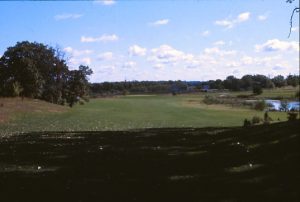
The second hole is a 135 yard par three, which requires an accurate first shot to an significantly elevated green.

The third hole is also a 119 yard par three, with a bubbling brook located 15 yards short of the partially elevated green.
The fourth hole is a par three uphill to a flat level green, which plays longer than its stated 175 yards.
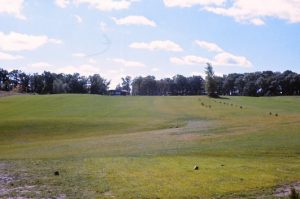
The fifth hole was originally a 135 yard par three with a partially elevated green located close to Silver Lake Road, with woods on either side, and a sand trap yawning on the western side of the green. However, the expansion of Silver Lake Road required the relocation of the fifth green thirty yards to the east, and the hole now plays to just 115 yards.
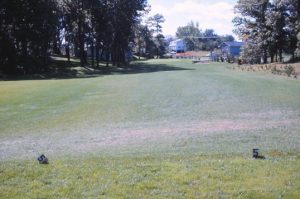
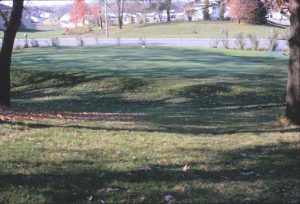
The sixth hole may be the most beautiful small course par four in Minnesota at 232 yards, with the tee located on a wooded hill, and the elevated green guarded by a large pond directly in front. Additional wetlands on the left-hand side, and woods on the right-hand side, require a straight tee shot, and a second shot either over or around the pond.
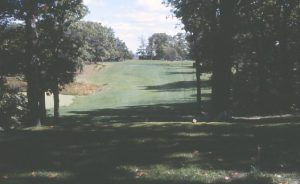
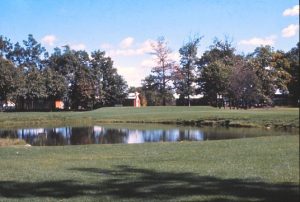
The seventh hole is the shortest on the course – just 90 yards long. Originally, the green was placed adjacent to the residences abutting the hole. However, the green was later moved farther to the west in order to accommodate the inevitable stray shots from the golfing public.
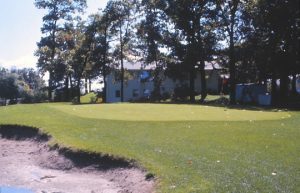
The eighth hole is a long 236 yard par four to an elevated green protected by wetlands on the left, and a creek in front of the green. Many a golfer has tried to reach the green directly from the tee, and wound up in the swamp.
The ninth hole – 164 yards – may be one of the toughest par three holes in Minnesota, with water flanking the fairway on the left, a small creek in front of the slightly elevated green, pine trees on the right side of the fairway, and large oak trees immediately behind the small green.
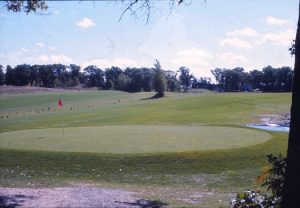
Conclusion – Brightwood Hills – 50 Years
Vince Dahle was one of New Brighton’s preeminent entrepreneurs of his era, who left a lasting legacy to the city – the Brightwood Hills golf course – a landmark which fostered a love of the game in generations of local golfers.

Silver Lake Road looking north from 17th Street NW – 1967.
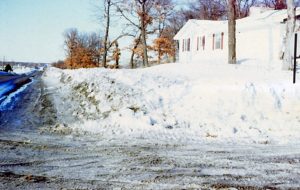
Gary C. Dahle – Attorney at Law
